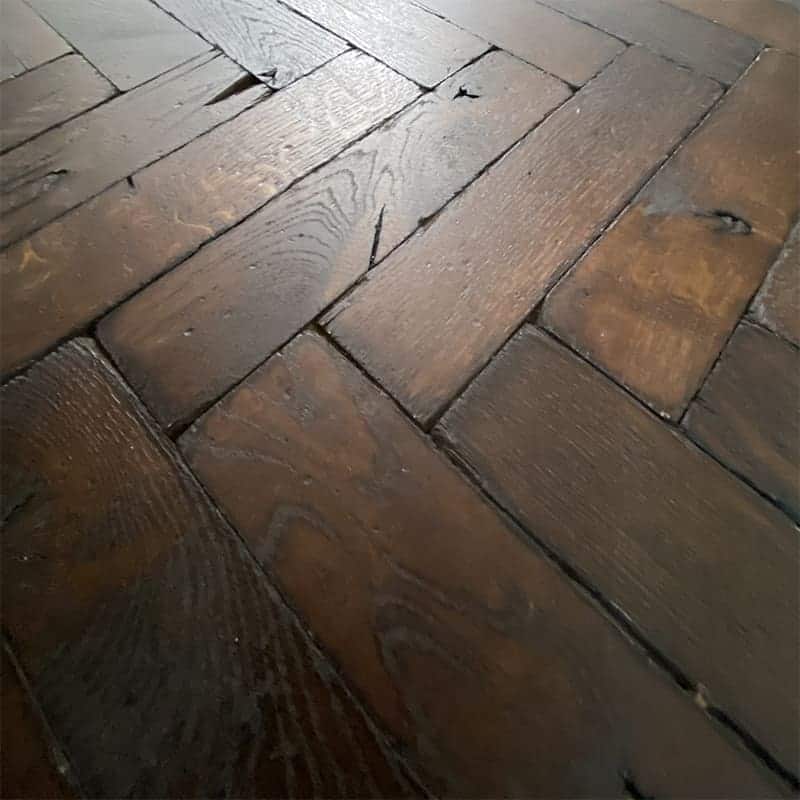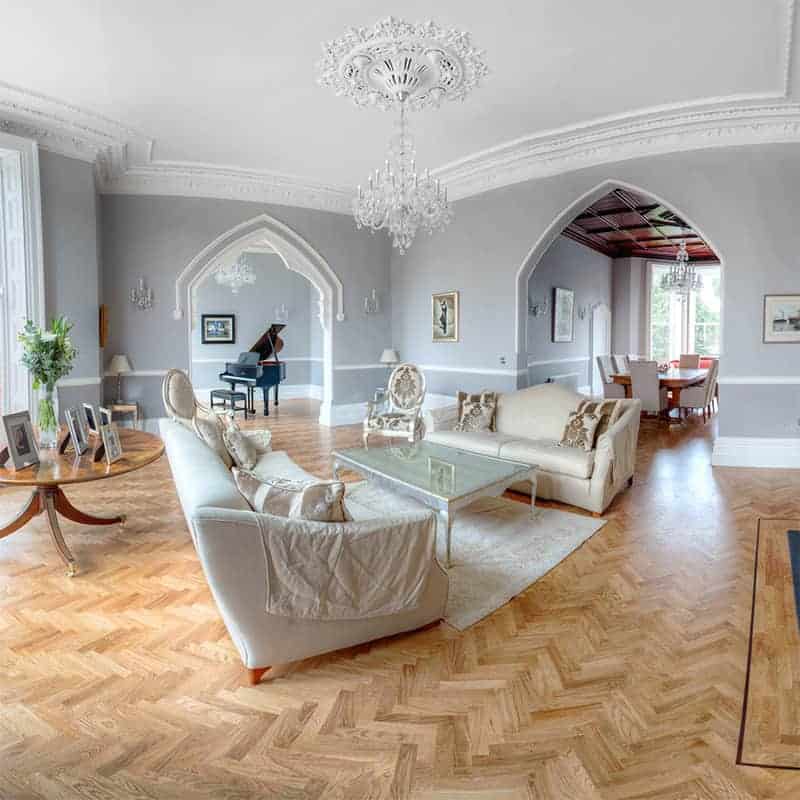If engineered hardwood parquet flooring is installed using the float flooring method it can be started in different ways depending on what way your fitter prefers. You can start by marking out your main center line in each separate room depending on the amount of parquet flooring that has to be fitted; this layout is similar to the glue down system discussed in my last blog. The other fitting option is you can start from a wall or an existing floored area. If the area is a large room or dance hall area or even a church area it would be best to start your own new line and then adjust your fitting when it comes to finishing the surrounding parquet flooring. Starting with your own new straight line will reduce the chances of your last row being narrow at one end and larger at the other, which may go unnoticed but does take away from the look of the parquet flooring design. if the walls are really off, which will be the case in an old building, this will end up happening regardless of how well you set your line out. If your area where your parquet flooring is being fitted and nothing is going to be matching up or uniform, then it would be ok to start from any existing walled area of tile or other floor area. When you start to fit floated parquet flooring the most popular areas to start from would be an existing line from another floored area in the property. Starting your first line with a floated flooring system even with a straight plank flooring system can be tricky, when it comes to fitting a parquet flooring floating system it can be made more difficult to fit as it can sometimes shift because it is sitting on foam. Again as I said before and I will always keep saying the right tool for the job will help so much when it comes to fitting parquet flooring . The tools needed are hammer, crowbar, small tapping block, miter saw, table saw and if you need to cut around objects a jig saw is the right tool to have while cutting odd shapes.
When it comes to fitting parquet flooring or any type of flooring the most important thing is the straight line. There are few ways in which a line will work for parquet flooring to strike or flick a chalk line or use a string line or a laser line, either one of these will be ok to use. Measure the room at both ends to see what the difference is and try and do your best to get the correct center line to work. Once you find the center point you are happy to add in your two makers just as if the subfloor is covered with an underlay you will have to use something like a maker so you can see your marks. You can then tap a nail into the mark and snap a line. When this is done you won’t have to mark out or make any other line like other systems of fitting parquet flooring for your parquet flooring as floated floors are continuous and are usually done in one line. Use the chalk line to line up or align every edge of your parquet flooring.
There are also a couple of styles of systems of fitting depending on the type of parquet flooring or the supplier you are buying from. Some products you can just glue wood adhesive along the tongue and groove of the boards, this system can be slower and you should always make sure to use a water proof adhesive.

As for cleaning and maintenance, water over time can break down in the joints and cause the flooring to come apart over the years. Some of the other fitting methods for parquet flooring are tap and lock or click systems. These products need to be placed closely together and tapped with a hammer and tapping block. The best way to achieve this is to put the two opposite ends of the parquet flooring together and with one sharp tap of the hammer they will click together, make sure you have placed the block as close as you can to the click joint as possible. This will prevent you from damaging your parquet flooring. If the parquet flooring you are tapping causes any movement to the rest of your parquet flooring, you can use a small wedge and place it into the expansion gap that is needed around the edges.
Once you have your first straight line in of your floated parquet flooring and all your blocks are nice and tightly fitted and secure, you can then start the rest of your fitting. Most floated parquet flooring products will have to be laid in gently to slide together at a 45 degree angle and then slight tapped with your rubber hammer or a small block, again check that when using your small block not to do any damage to the tongue and groove of your parquet flooring, as this will have an affect on the rest of the parquet flooring you fit in or even worse knock out your line. Please make sure you read all of the manufacture instruction when it comes to joining the parquet flooring as if it is a click system being used it is important to compress or push down towards your subfloor for it to lock together again a good solid tapping block is important to have to hand when fitting this style of parquet flooring. When you have completed your parquet flooring out to near the edges of the wall, you can start setting up to start your cuts. Take a piece of your parquet flooring and mark the opposite end of the tongue and groove and do your 45 degree cut, you can then take the piece and check that it fits at both ends of your parquet flooring. Usually it is good to count how many pieces are required and set your chop saw up for repeat cuts of the same length and depending on the size of your chop saw you can cut a couple of pieces of parquet flooring to speed things up.

At this point of fitting you will see the benefit of striking your straight line to the walls as all your cuts from top to bottom will be the same dimension. If your parquet flooring is on the lock and clip system the approach to fitting is slightly different when it comes to fitting around the edges where your cuts are. Unlike hardwood parquet flooring or traditional engineered parquet you will have to remove a part of the locking or clipping system that would be on the product. This clipping system for your parquet flooring will have a raised section on the tongue and groove, cut this off using your table saw or depending on the product a knife or a fine chisel is good enough to remove this from the parquet flooring. When you get to the wall for the smaller pieces by removing the locking system it will make it easier to slide the smaller pieces together. This is the part of fitting parquet flooring that can be time consuming and tedious and will test your patience from time to time. It is important not to forget to leave your minimum of 10 mm gap for movement and expansion. You will need to use your rubber hammer and your crowbar to pull all the parquet flooring blocks together. Again with clip system the same can be applied but you will need your tapping block to complete these areas. When you have completed this side of your room, you can then carry on the process on the other side of your striked line.
When it comes to the floating system there are many other styles of flooring you can do, like laminate and vinyl parquet flooring designs. With these styles of floated floors they are cut a different way and with a machine that will just snap the product where you mark your cut line, this is much faster and will let you have a much cleaner area. But one of the main drawbacks with this is if the floors get damaged or scratched over time, you will not have the option of sanding and polishing the parquet flooring back to its original beauty. Once this has happened it will usually have to be left there, as it can be impossible to remove or replace these styles of parquet flooring.
When it comes to most styles of parquet flooring especially the floated systems. The hardest thing to control is the sound. When you are dealing with high rise buildings and apartments most clients or contractors will value the sound control between your floors and parquet flooring. In these types of structures it is critical to know the standards required for the local structures and the design specifications for the building. There are many types of sounds that the building designers will be concerned about, but the main ones are; impact noise which will happen when you have a lot of footfall and the other is airborne sounds which are caused by music or voices. Most building structures will require a basic reduced level of impact and airborne sounds when any parquet flooring or floated floors are being installed within the structure. But most of your manufactures or suppliers will have suitable products to reach these required standards. When laying your parquet flooring on an acoustic underlay to meet the requirements, there is no more need for further requirements at this stage unless more is needed by the client or contractor.

Many of the manufacturers that supply these acoustic underlay products will promise certain levels of noise abatement and these can be worked into the design specifications. Some wood flooring and parquet flooring with impact or airborne sounds do not always have the same degree of noise. Using different products and underlays on a given subfloor assembly have not been shown to make that much of a difference on airborne sound transmissions. So this is one of the main reasons why from an installation point of view it is always best to use the gluing down system, so that you don’t get pulled into all the necessary requirements in these types of structures when it comes to a float floor.
Regardless of any of the products and no matter how good they are, they really only dampen down the impact of sound in the structure. There is a wide range of different products available to reduce sound transmission through floated parquet flooring. The most important point is to isolate the parquet flooring from the rest of the building structure. To have this system of work at its best when using your acoustic underlay is to also apply a cork underlay, fiber matting, foam or composite membrane. You can also glue your parquet flooring to the acoustical membrane that is also glued to the subfloor. Engineered parquet flooring can be floated over the same material, either way the more the acoustic membrane the better the isolation of sound. Also with solid plank flooring you can also nail your flooring to a plywood subfloor that is floated over the layer of acoustical membrane, as long as none of the nails penetrate through the acoustic membrane and hit the building structure. If this happens then the whole process is compromised as the sound barriers will not be as effective. Another mistake that can happen when floating your parquet flooring is when fitting happens around the side of the structure. You must avoid at all cost in making contact with the walls, as this will also transmit sound and render the acoustic sound barrier useless, as the sound on the parquet flooring will travel straight through all the walls.

The gap that you leave between the parquet flooring should be filled with the same vibration material as the underlay. Leaving this gap is very important to level, as it allows the parquet flooring to move and prevents the sound from traveling across the parquet flooring.
Parquet Flooring Options
MM Parquet & Carpentry Ltd can supply and fit the full range of traditional parquet flooring, tumbled parquet flooring and reclaimed parquet flooring, please click here for more examples of parquet flooring.



